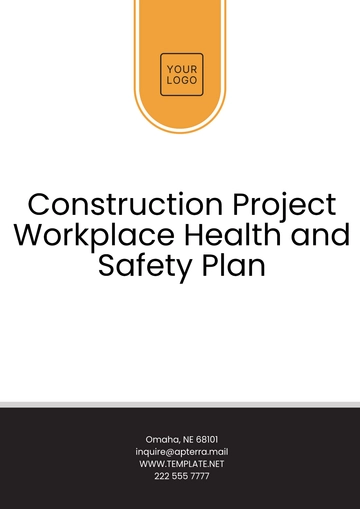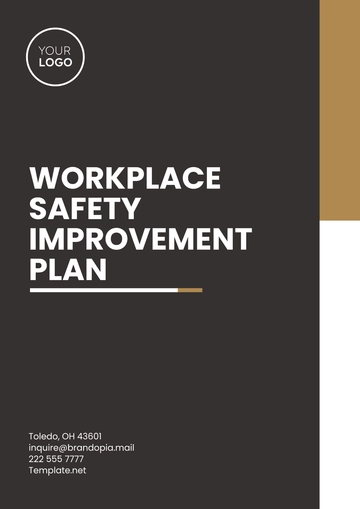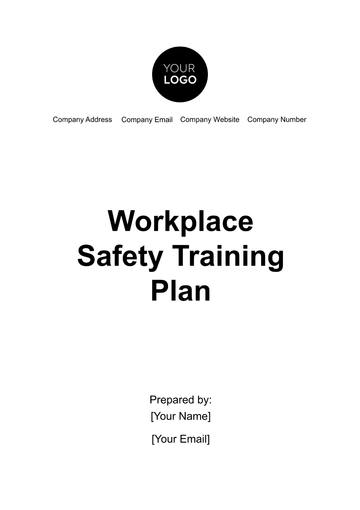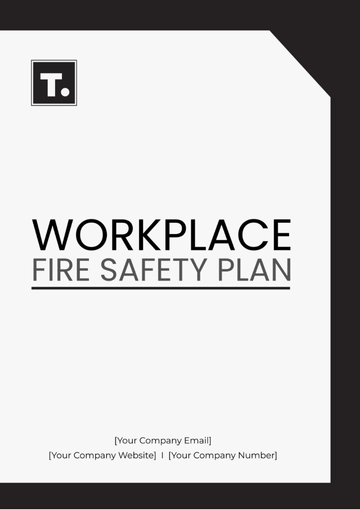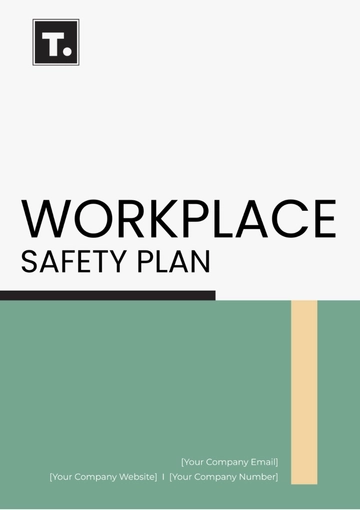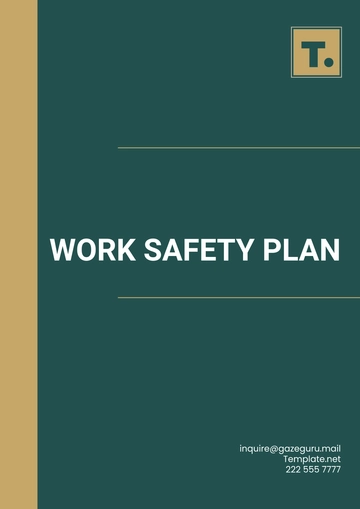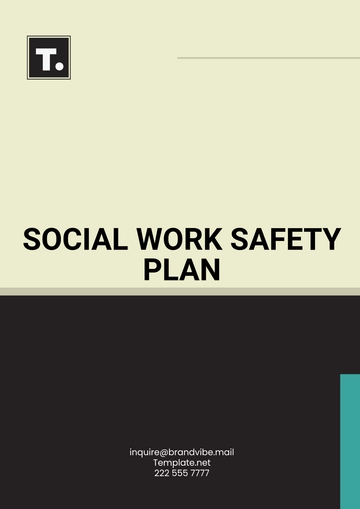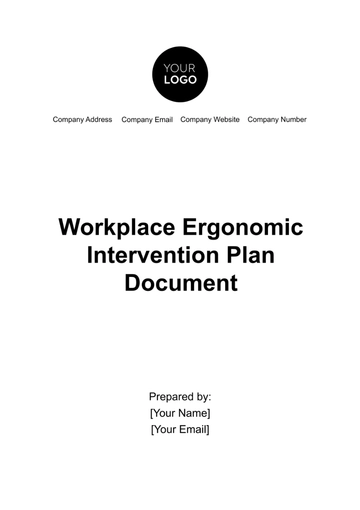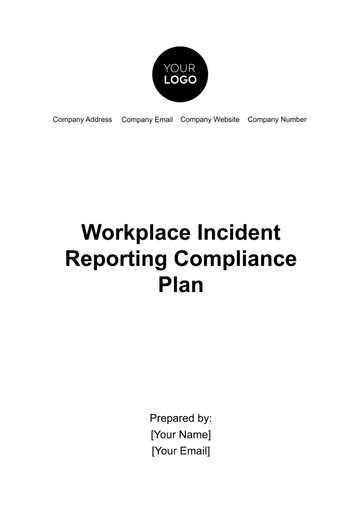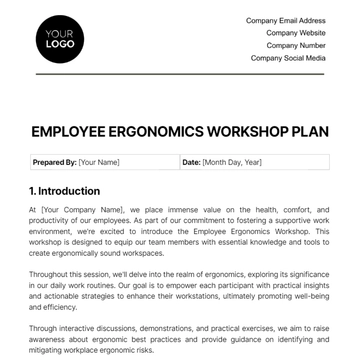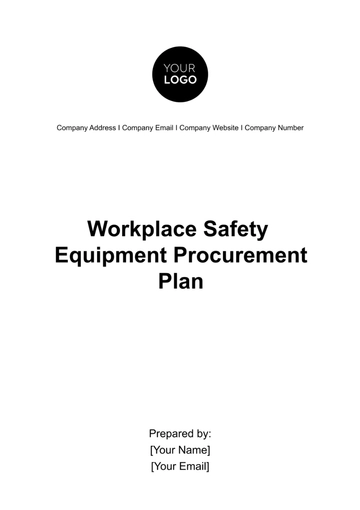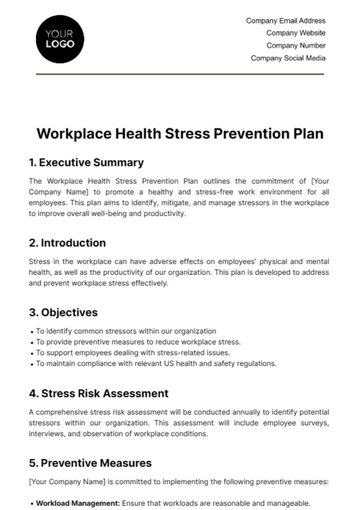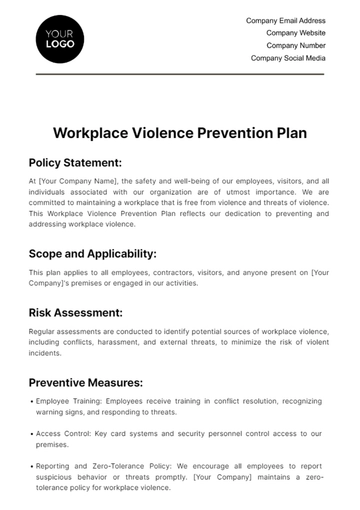Free Construction Project Workplace Health and Safety Plan
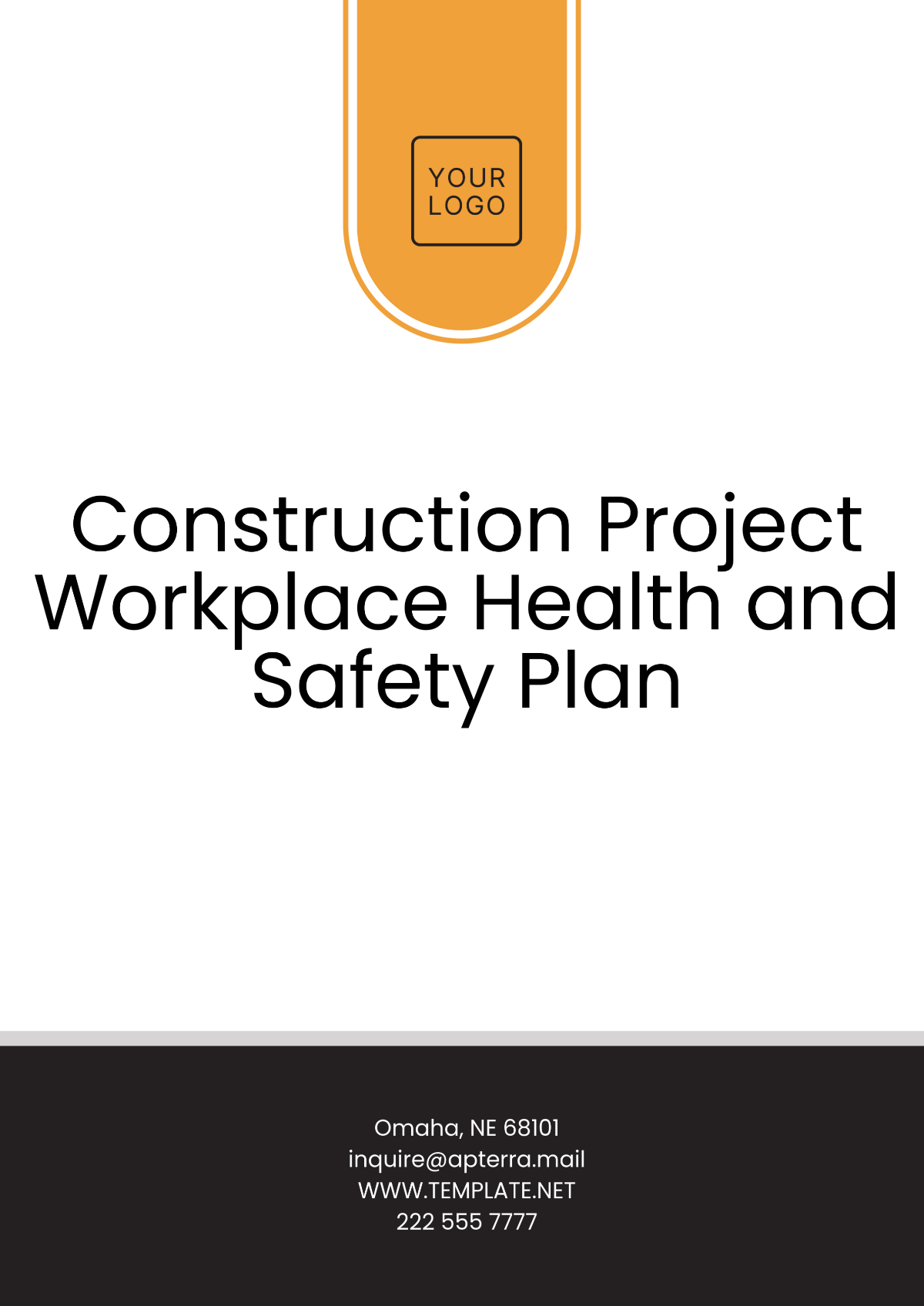
Prepared by: [Your Name]
Company: [Your Company Name]
Date: January 1, 2060
1. Introduction
The objective of this Workplace Health and Safety Plan is to provide a comprehensive framework that ensures the health, safety, and well-being of all personnel involved in the construction project. This plan outlines policies, procedures, and control measures to prevent accidents, minimize health risks, and create a safe working environment for workers, contractors, and visitors. Safety is an integral part of the project, and this plan serves as the foundation for maintaining a safe working environment throughout the duration of the project.
2. Scope
This health and safety plan applies to all activities, personnel, and processes associated with the construction project. It is applicable to all employees, subcontractors, visitors, and stakeholders involved in the project, including site supervisors, management, and safety officers. The plan covers all phases of the project, from pre-construction through to project completion and post-project evaluation.
3. Responsibilities and Roles
3.1 Project Manager
Overall responsibility for implementing the health and safety plan.
Ensure compliance with all applicable safety regulations and standards.
Allocate necessary resources for maintaining a safe worksite.
Review and update safety policies as required throughout the project lifecycle.
3.2 Safety Officer
Monitor safety practices daily and conduct regular site inspections.
Lead the investigation of incidents and recommend corrective actions.
Ensure all safety protocols are being followed and recommend improvements.
Ensure compliance with OSHA standards and local safety regulations.
Coordinate with emergency response teams and maintain emergency response equipment.
3.3 Site Supervisors
Enforce safety measures within their designated areas.
Conduct toolbox talks and site-specific safety briefings.
Ensure proper use of personal protective equipment (PPE) among workers.
Supervise and support workers to ensure safe practices are maintained on-site.
3.4 Employees and Subcontractors
Follow all safety protocols and procedures established for the project.
Use PPE at all times as required.
Report hazards, unsafe practices, or accidents to supervisors immediately.
Participate in safety training and contribute to the continuous improvement of safety standards.
4. Risk Assessment and Management
4.1 Risk Identification
Risk assessments shall be conducted before the commencement of any construction activity. The aim is to identify hazards related to specific tasks and processes that could endanger the health and safety of workers. These risk assessments will be ongoing and updated regularly, particularly when site conditions change or new tasks are introduced.
4.2 Risk Control Measures
Control measures will be designed based on the risk levels identified. Control measures must be implemented before work begins to minimize risks. A hierarchy of controls will be applied in the following order:
Elimination: Remove the hazard from the workplace.
Substitution: Replace the hazard with a safer alternative.
Engineering Controls: Use technology to reduce exposure to hazards.
Administrative Controls: Implement procedures and practices that reduce exposure to hazards.
Personal Protective Equipment (PPE): Use of appropriate PPE to protect workers.
4.3 Task-Based Risk Assessment
Task | Hazard | Risk Level | Control Measures |
|---|---|---|---|
Excavation | Cave-ins | High | Shoring and trench boxes; barricades to prevent unauthorized entry |
Welding | Fire hazards | Medium | Use of fire-resistant blankets; fire extinguishers on site |
Working at Heights | Falls | High | Guardrails, fall protection systems, harnesses, and lifelines |
Handling Hazardous Materials | Chemical exposure | Medium | Use of proper containment methods and PPE (e.g., gloves, respirators) |
Moving Heavy Equipment | Crushing, pinching | High | Use of spotters, proper signaling, and barrier systems |
5. Safety Training and Communication
5.1 Induction Training
All new employees and subcontractors must attend a comprehensive safety induction program. This program will cover:
General safety principles.
Site-specific hazards and risks.
Emergency procedures.
Proper use of PPE.
Reporting procedures for hazards and incidents.
5.2 Toolbox Talks
Regular toolbox talks will be conducted by site supervisors to address:
Recent incidents or near misses.
Site-specific safety topics.
Updates to safety procedures or regulations.
Reinforcement of the use of PPE and safe work practices.
5.3 Safety Meetings
Monthly safety meetings will be held to:
Review safety performance.
Discuss areas for improvement.
Engage workers in the identification of hazards and solutions.
Provide a platform for open communication between workers and management.
6. Emergency Procedures
In the event of an emergency, all workers should follow the established emergency procedures. These procedures include actions to be taken for various emergency scenarios, such as fires, medical emergencies, chemical spills, and evacuations.
6.1 Fire Emergency
Sound the alarm immediately and evacuate the area.
Notify emergency services.
Use fire extinguishers, if safe to do so.
6.2 Medical Emergency
Contact first responders and provide first aid if trained.
Ensure the injured person is moved safely if required.
Document the incident for reporting purposes.
6.3 Chemical Spill
Contain the spill using appropriate spill containment materials.
Evacuate the affected area and notify the Safety Officer.
Follow proper disposal protocols for hazardous materials.
6.4 Site Evacuation
Marked evacuation routes and assembly points.
Conduct regular evacuation drills to ensure all personnel are familiar with procedures.
7. Incident Reporting and Investigation
All incidents, including near misses, must be reported immediately to site supervisors or the Safety Officer. An investigation will follow to identify the root cause and prevent recurrence. The investigation will include:
Interviews with involved personnel.
Review of safety procedures and training.
Evaluation of the adequacy of control measures.
The results of the investigation will be communicated to all personnel, and corrective actions will be implemented where necessary.
8. Personal Protective Equipment (PPE)
PPE is essential for reducing exposure to workplace hazards. The following PPE requirements must be adhered to:
Hard hats for head protection.
Safety goggles to protect eyes from flying debris and chemicals.
Hearing protection when working in high-noise environments.
High-visibility vests or clothing for better visibility.
Gloves to protect hands from cuts, burns, and chemicals.
Respirators where there is a risk of airborne contaminants.
PPE must be inspected regularly and replaced when damaged.
9. Monitoring, Auditing, and Review
9.1 Regular Safety Audits
Regular safety audits will be conducted by the Safety Officer to:
Assess compliance with safety protocols.
Identify potential hazards or areas of improvement.
Ensure that PPE is being used correctly.
Evaluate the effectiveness of risk control measures.
9.2 Ongoing Safety Inspections
Daily inspections will be conducted to ensure that safety standards are being maintained. This includes checking the integrity of safety barriers, machinery, scaffolding, and PPE usage.
9.3 Annual Reviews
The safety plan will be reviewed annually to assess its effectiveness. The review will include an evaluation of incident reports, changes in regulations, new site risks, and feedback from employees.
10. Conclusion
This Workplace Health and Safety Plan is a living document that will evolve to ensure the safety and well-being of all personnel throughout the project. A strong safety culture, continuous monitoring, and commitment to ongoing improvement are fundamental to achieving a zero-accident worksite. By adhering to this plan, we aim to provide a safe and productive environment for all workers involved in the construction project.
- 100% Customizable, free editor
- Access 1 Million+ Templates, photo’s & graphics
- Download or share as a template
- Click and replace photos, graphics, text, backgrounds
- Resize, crop, AI write & more
- Access advanced editor
Ensure a safe and compliant construction site with the Construction Project Workplace Health and Safety Plan Template from Template.net. This editable and customizable template allows you to tailor the plan to your specific project needs. Editable in our AI Editor Tool, it provides a streamlined and efficient way to manage health and safety requirements.
You may also like
- Finance Plan
- Construction Plan
- Sales Plan
- Development Plan
- Career Plan
- Budget Plan
- HR Plan
- Education Plan
- Transition Plan
- Work Plan
- Training Plan
- Communication Plan
- Operation Plan
- Health And Safety Plan
- Strategy Plan
- Professional Development Plan
- Advertising Plan
- Risk Management Plan
- Restaurant Plan
- School Plan
- Nursing Home Patient Care Plan
- Nursing Care Plan
- Plan Event
- Startup Plan
- Social Media Plan
- Staffing Plan
- Annual Plan
- Content Plan
- Payment Plan
- Implementation Plan
- Hotel Plan
- Workout Plan
- Accounting Plan
- Campaign Plan
- Essay Plan
- 30 60 90 Day Plan
- Research Plan
- Recruitment Plan
- 90 Day Plan
- Quarterly Plan
- Emergency Plan
- 5 Year Plan
- Gym Plan
- Personal Plan
- IT and Software Plan
- Treatment Plan
- Real Estate Plan
- Law Firm Plan
- Healthcare Plan
- Improvement Plan
- Media Plan
- 5 Year Business Plan
- Learning Plan
- Marketing Campaign Plan
- Travel Agency Plan
- Cleaning Services Plan
- Interior Design Plan
- Performance Plan
- PR Plan
- Birth Plan
- Life Plan
- SEO Plan
- Disaster Recovery Plan
- Continuity Plan
- Launch Plan
- Legal Plan
- Behavior Plan
- Performance Improvement Plan
- Salon Plan
- Security Plan
- Security Management Plan
- Employee Development Plan
- Quality Plan
- Service Improvement Plan
- Growth Plan
- Incident Response Plan
- Basketball Plan
- Emergency Action Plan
- Product Launch Plan
- Spa Plan
- Employee Training Plan
- Data Analysis Plan
- Employee Action Plan
- Territory Plan
- Audit Plan
- Classroom Plan
- Activity Plan
- Parenting Plan
- Care Plan
- Project Execution Plan
- Exercise Plan
- Internship Plan
- Software Development Plan
- Continuous Improvement Plan
- Leave Plan
- 90 Day Sales Plan
- Advertising Agency Plan
- Employee Transition Plan
- Smart Action Plan
- Workplace Safety Plan
- Behavior Change Plan
- Contingency Plan
- Continuity of Operations Plan
- Health Plan
- Quality Control Plan
- Self Plan
- Sports Development Plan
- Change Management Plan
- Ecommerce Plan
- Personal Financial Plan
- Process Improvement Plan
- 30-60-90 Day Sales Plan
- Crisis Management Plan
- Engagement Plan
- Execution Plan
- Pandemic Plan
- Quality Assurance Plan
- Service Continuity Plan
- Agile Project Plan
- Fundraising Plan
- Job Transition Plan
- Asset Maintenance Plan
- Maintenance Plan
- Software Test Plan
- Staff Training and Development Plan
- 3 Year Plan
- Brand Activation Plan
- Release Plan
- Resource Plan
- Risk Mitigation Plan
- Teacher Plan
- 30 60 90 Day Plan for New Manager
- Food Safety Plan
- Food Truck Plan
- Hiring Plan
- Quality Management Plan
- Wellness Plan
- Behavior Intervention Plan
- Bonus Plan
- Investment Plan
- Maternity Leave Plan
- Pandemic Response Plan
- Succession Planning
- Coaching Plan
- Configuration Management Plan
- Remote Work Plan
- Self Care Plan
- Teaching Plan
- 100-Day Plan
- HACCP Plan
- Student Plan
- Sustainability Plan
- 30 60 90 Day Plan for Interview
- Access Plan
- Site Specific Safety Plan
